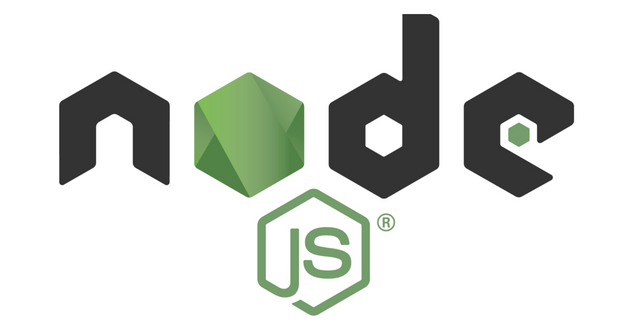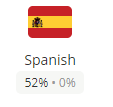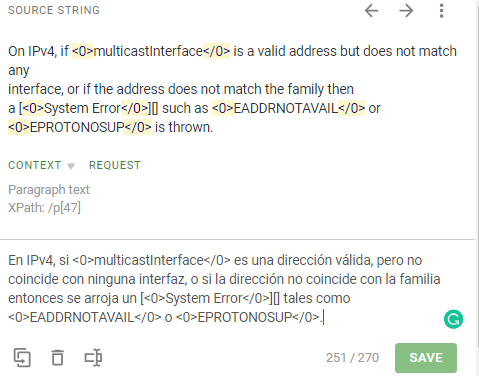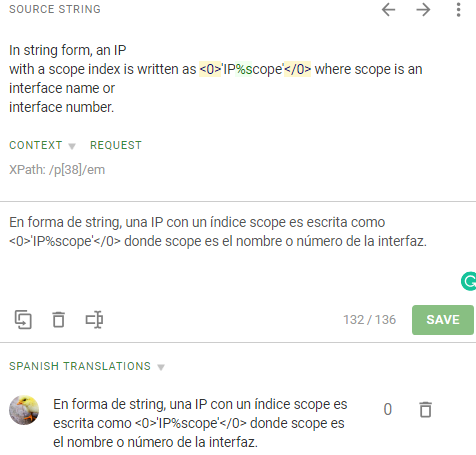Spanish Translation of Node.js (Part 4) (1070 words)

Github Repository
https://github.com/nodejs/i18n
Project Details
Node.js is:
What is it for?
Node.js lights in real-time web applications employing push technology over web sockets. Node.js allows having web applications with real-time, two-way connections, where both, the client and server can initiate communication, allowing them free data exchange. It can handle many concurrent connections at a time. It is built on Chrome’s V8 JavaScript engine and uses an event-driven, non-blocking I/O model that makes it lightweight and efficient. Node.js now plays a critical role in the technology stack of many high-profile companies who depend on its unique benefits.
SOURCE 1
SOURCE 2
Contribution Specifications
Node.js is currently being translated into 33 languages and I am contributing to translate it into Spanish. 52% of the whole the project has been translated.

During this 4th translation, I continued working on dgram.md. So far I have translated

This segment basically explains how to use the module dgram.
Just as a short reminding, a datagram is the basic unit through which all data collected in the network can be transferred on this layer 3 IP protocoll. It provides a connectionless communication service across a packet-switched network.
SOURCE
How it works?
SOURCE
Over this translation, I discovered the IPv4 concept or Internet Protocol version 4 which is the fourth version of the Internet Protocol (IP). It is one of the core protocols of standards-based internetworking methods on the Internet. IPv4 is a connectionless protocol used in packet-switched layer networks, such as Ethernet(an array of networking technologies and systems used in local area networks (LAN), where computers are connected within a primary physical space.)
The figure shows the encapsulation of a UDP datagram as a single IPv4 datagram.

Languages
• Source Language: English
• Translated Language: Spanish
Word Count
Words translated on this contribution: 1070 words.
1st contribution
2nd contribution
3rd contribution
Proof of Authorship
The translation was submitted via Crowdin. All relevant information on the following links.
Node.js Crowdin page
My Crowdin Profile
My Crowdin Activity
Examples of my translations<-b>



Hi @rositaumce,
Thank you for submitting your contribution!
Node.js is a very interesting project that contains many code values and terms related to computer science. Its difficulty relies on the fact that we must pay a lot of attention to the code in order to deliver the most accurate translation possible.
Your presentation post it's informative as it provides useful and relevant details related to your contribution to the project. You also shared clear concepts you learned this time.
You did a very good job with your translation, you are getting familiar with the project's terminology, which is totally normal. The important thing is to always be careful with code values that should not be translated.
I'm looking forward to your next contribution :)
Your contribution has been evaluated according to Utopian policies and guidelines, as well as a predefined set of questions pertaining to the category.
To view those questions and the relevant answers related to your post, click here.
Chat with us on Discord
Thank you for your review, @marugy99! Keep up the good work!
Hi @rositaumce!
Your post was upvoted by @steem-ua, new Steem dApp, using UserAuthority for algorithmic post curation!
Your post is eligible for our upvote, thanks to our collaboration with @utopian-io!
Feel free to join our @steem-ua Discord server
Hey, @rositaumce!
Thanks for contributing on Utopian.
We’re already looking forward to your next contribution!
Get higher incentives and support Utopian.io!
Simply set @utopian.pay as a 5% (or higher) payout beneficiary on your contribution post (via SteemPlus or Steeditor).
Want to chat? Join us on Discord https://discord.gg/h52nFrV.
Vote for Utopian Witness!